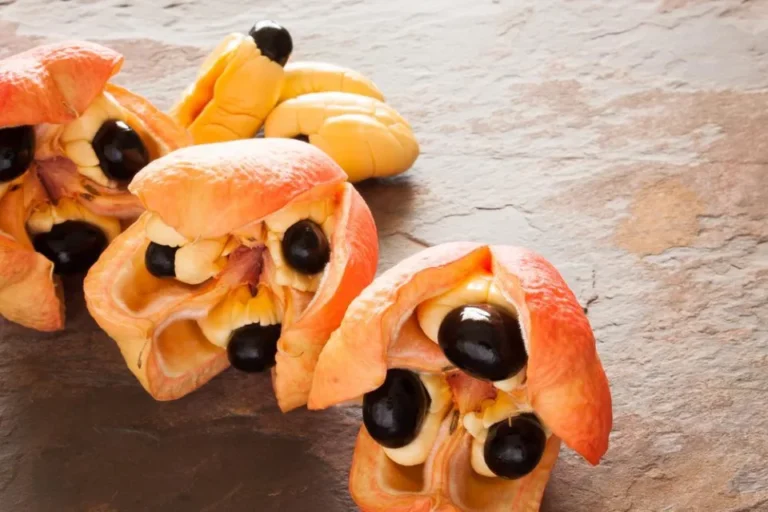Types of Ackee
Ackee, a staple in the Caribbean, especially in Jamaican cuisine, is celebrated not only for its delicious flavor but also for its cultural significance.
In Jamaica, the two main types of ackee are ‘Butter’ ackee and ‘Cheese’ ackee.
They are differentiated by the color and texture of their arils (the edible portions of the fruit). (Arils are the fleshy parts surrounding the black seeds, and are cream to yellow in color).
What is Butter Ackee?
Butter ackee is named for its soft, yellow arils that have a buttery texture and a mild, delicate flavor.
This variety is particularly favored for its creamy consistency, which blends well into some dishes.
Characteristics: The arils of butter ackee are soft and vibrant yellow, providing a visually appealing look in dishes.
Common Locations: This type of ackee is widely found across Jamaica.
Uses: Due to its naturally creamy and soft texture, butter ackee is exceptionally well-suited for culinary applications where smoothness is key. It excels in the preparation of desserts such as cakes and in custards or rich, creamy sauces, where its smoothness can enhance the dish’s overall texture. When used in recipes for crème brûlée or ice cream, butter ackee features a silky, smooth consistency that elevates these dishes, making it an ideal choice for those seeking to infuse a subtle, rich flavor and delicate texture into their desserts.
What Is Cheese Ackee?
Cheese ackee features cream-colored arils.
This variety has a firmer texture, which holds up better during cooking, making it suitable for dishes where a more defined ackee presence is desired.
Characteristics: The arils of cheese ackee are cream-colored and harder than those of butter ackee, offering a different texture and slightly less creaminess.
Common Locations: Like butter ackee, cheese ackee is also prevalent in Jamaica and can be found across Jamaica.
Uses: Due to its firmer texture, cheese ackee is excellent for culinary applications where the ackee needs to stay intact during cooking. This variety is the preferred choice for traditional dishes like ackee and saltfish, where it can withstand the tossing and stirring involved in the cooking process without breaking apart. Its resilience also makes it excellent for inclusion in recipes such as stuffed pita pockets or ackee stir-fries. Cheese ackee’s ability to hold its shape under these conditions ensures that it contributes texture as well as flavor to the dish.
Tips for Cooking Butter Ackee
- Gentle Cooking: Since butter ackee has a softer texture, it’s best to cook it gently to prevent it from becoming mushy. Light sautéing or steaming works well.
- Quick Addition: Add butter ackee towards the end of the cooking process in most dishes. This helps preserve its creamy texture and prevents it from disintegrating.
- Cream-Based Dishes: Utilize butter ackee in creamy dishes like sauces or as a filling in pastries where its texture can be a creamy highlight without requiring long cooking times.
Tips for Cooking Cheese Ackee
- Robust Cooking: Cheese ackee can withstand more vigorous cooking methods due to its firmer texture. It’s ideal for frying, baking, or any dish that involves stirring and mixing.
- Textural Contrast: Use cheese ackee in dishes where you want to stay intact during cooking. It’s excellent in stir-fries, stews, and dishes like ackee and saltfish where it can be tossed around without breaking.
- Longer Cooking Time: Cheese ackee can handle longer cooking times, which makes it suitable for dishes that require simmering and developing flavors over time.
Note: Although cheese ackee is referred to as the “firmer” variety, cheese ackee is still soft compared to other cooking ingredients like root vegetables or meat. It holds up slightly better under heat, making it suitable for dishes that involve stirring or where a bit of texture is needed. However, it is important to note that it can still break apart if handled too vigorously. It is firmer relative to butter ackee but still requires careful handling to keep its pieces intact throughout the cooking process.
Canned Ackee
Although cheese ackees are the preferred variety for canning due to their firmer texture, once processed, their texture becomes softer, resembling that of butter ackee.
As a result, canned ackees should be handled gently during cooking to maintain their delicate structure.
Which Type of Ackee Is The Best?
The choice between butter and cheese ackee often depends on culinary tradition and personal preference.
In Jamaica, the availability of each type can vary by region, influencing what is commonly used in households and restaurants.
Generally, cheese ackee is favored for its ability to maintain its structure in popular dishes like ackee and saltfish, where its firmer texture is essential for withstanding the cooking process.
Personal history also plays a significant role in preference; many Jamaicans develop a deep-rooted loyalty to the type of ackee they most frequently grew up eating, which influences their choices in both home cooking and dining out.
Ultimately, both types have their merits, and the best choice depends on the specific requirements of the dish being prepared and the cook’s taste.
For those outside of Jamaica, canned ackee, which is often cheese ackee due to its sturdier nature, is commonly used due to its broader availability.
Safety Tips for Both Types of Ackee
- Ensure Ripeness: Always ensure that the ackee is fully ripe (naturally opened on the tree) before harvesting (picking), to avoid the risk of toxicity from hypoglycin A.
- Proper Cleaning: Remove all the red fibers and the seeds, as these parts are toxic. You should only use the yellow arils.
- Boil Before Use: Boil the cleaned arils, then drain the water.
- Canned Ackee: Canned ackee is a convenient option as it has been pre-cooked and is ready to use. However, it is essential to drain the ackee thoroughly after opening the can to remove the canning liquids. As the ackee in cans is already cooked, be gentle when mixing it into your dishes to maintain its texture.
These tips should help you maximize the culinary potential of both butter ackee and cheese ackee, allowing you to explore a range of dishes that highlight their distinct textures and flavors.
Conclusion
Ackee, with its rich flavor and cultural depth, continues to be a beloved staple in Jamaican and Caribbean cuisines.
It stands out not only as a key ingredient but also as a cultural symbol that resonates with the rhythms of Jamaican dining tables.
The distinction between Butter and Cheese ackee encapsulates the diversity of Jamaican culinary practices, where each variety represents more than just a personal preference—it’s a testament to the rich array of flavors that define the island.
Whether you prefer the creamy softness of Butter ackee or the firmer texture of Cheese ackee, each type brings unique qualities to both traditional dishes and innovative culinary creations.
For culinary enthusiasts and chefs alike, understanding these differences is crucial for mastering the art of Caribbean cuisine.
By embracing the distinct characteristics of each type of ackee, one can truly celebrate the sophisticated textures and flavors it has to offer, ensuring that every dish is not just a meal but a story told through food.





